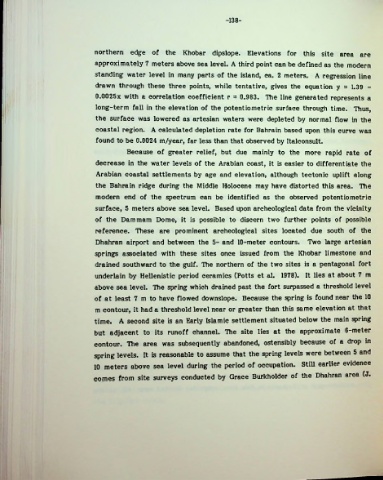Page 162 - Life & Land Use on the Bahrain Islands (Curtis E Larsen)
P. 162
-138-
northern edge of the Khobar dipslope. Elevations for this site area are
approximately 7 meters above sea level. A third point can be defined as the modern
standing water level in many parts of the island, ca. 2 meters. A regression line
drawn through these three points, while tentative, gives the equation y = 1.39 -
0.0025x with a correlation coefficient r = 0.983. The line generated represents a
long-term fall in the elevation of the potentiometric surface through time. Thus,
the surface was lowered as artesian waters were depleted by normal flow in the
coastal region. A calculated depletion rate for Bahrain based upon this curve was
found to be 0.0024 m/year, far less than that observed by Italconsult.
Because of greater relief, but due mainly to the more rapid rate of
decrease in the water levels of the Arabian coast, it is easier to differentiate the
Arabian coastal settlements by age and elevation, although tectonic uplift along
the Bahrain ridge during the Middle Holocene may have distorted this area. The
modern end of the spectrum can be identified as the observed potentiometric
surface, 5 meters above sea level. Based upon archeological data from the vicinity
of the Dammam Dome, it is possible to discern two further points of possible
reference. These are prominent archeological sites located due south of the
Dhahran airport and between the 5- and 10-meter contours. Two large artesian
springs associated with these sites once issued from the Khobar limestone and
drained southward to the gulf. The northern of the two sites is a pentagonal fort
underlain by Hellenistic period ceramics (Potts et al. 1978). It lies at about 7 m
above sea level. The spring which drained past the fort surpassed a threshold level
of at least 7 m to have flowed downslope. Because the spring is found near the 10
m contour, it had a threshold level near or greater than this same elevation at that
time. A second site is an Early Islamic settlement situated below the main spring
but adjacent to its runoff channel. The site lies at the approximate 6-meter
contour. The area was subsequently abandoned, ostensibly because of a drop in
spring levels. It is reasonable to assume that the spring levels were between 5 and
10 meters above sea level during the period of occupation. Still earlier evidence
comes from site surveys conducted by Grace Burkholder of the Dhahran area (J.

